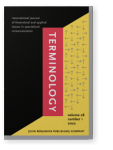Vol. 28:1 (2022) ► pp.157–189
Tagging terms in text
A supervised sequential labelling approach to automatic term extraction
As with many tasks in natural language processing, automatic term extraction (ATE) is increasingly approached as a machine learning problem. So far, most machine learning approaches to ATE broadly follow the traditional hybrid methodology, by first extracting a list of unique candidate terms, and classifying these candidates based on the predicted probability that they are valid terms. However, with the rise of neural networks and word embeddings, the next development in ATE might be towards sequential approaches, i.e., classifying each occurrence of each token within its original context. To test the validity of such approaches for ATE, two sequential methodologies were developed, evaluated, and compared: one feature-based conditional random fields classifier and one embedding-based recurrent neural network. An additional comparison was added with a machine learning interpretation of the traditional approach. All systems were trained and evaluated on identical data in multiple languages and domains to identify their respective strengths and weaknesses. The sequential methodologies were proven to be valid approaches to ATE, and the neural network even outperformed the more traditional approach. Interestingly, a combination of multiple approaches can outperform all of them separately, showing new ways to push the state-of-the-art in ATE.
Article outline
- 1.Introduction
- 2.Related research
- 2.1Machine learning approaches
- 2.2Evaluation
- 2.3Features
- 2.4Sequential approaches
- 3.Data
- 4.System description
- 4.1CRFSuite feature-based sequential ATE
- 4.2FlairNLP neural, embedding-based sequential ATE
- 4.3HAMLET machine learning approach to traditional hybrid ATE
- 5.Experiments and results
- 5.1Experimental setup
- 5.2CRF results
- 5.3RNN results
- 6.Analyses and discussion of results
- 6.1Choice of experiments and motivation
- 6.2Results per corpus
- 6.3Sequential, neural approach vs. traditional, feature-based approach
- 6.4Complementarity of results
- 7.RNN error analysis
- 8.Conclusion
- Notes
-
References
